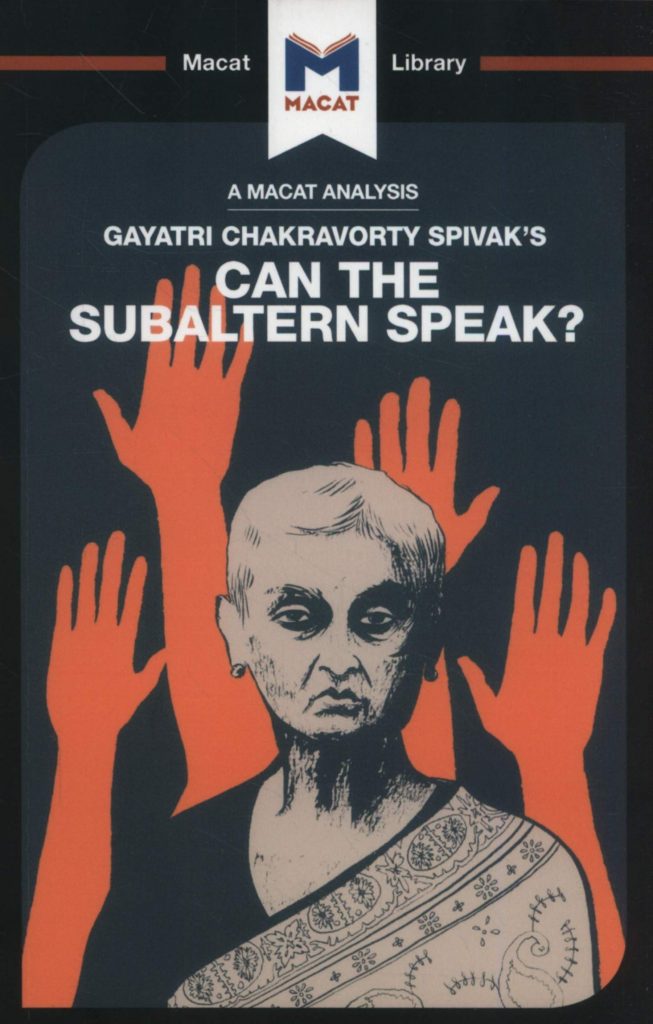Share this Collection
2 Citations in this Annotation:
Annotated by:
Anoma Pieris on Borderlands/La Frontera and Can the Subaltern Speak?
13 May, 2021
 Gayatri Chakravorty Spivak’s famous essay ‘Can the Subaltern Speak?’ highlighted the entitlements that guarantee visibility and vocality for some and not for others; and asked for greater self-reflexivity when writing on those without the agency to represent their interests. Her essay critiqued the Subaltern Studies Collective, a group aligned with Postcolonial Studies, predominantly South Asian scholars who explored Antonio Gramsci’s ideas in understanding non-elite forms of anti-colonial resistance. Their scholarship informed my PhD research project Hidden Hands and Divided Landscapes: a Penal History of Singapore’s Plural Society (2009), examining colonial architecture and urbanism’s reliance on transported convict labourers.
Gayatri Chakravorty Spivak’s famous essay ‘Can the Subaltern Speak?’ highlighted the entitlements that guarantee visibility and vocality for some and not for others; and asked for greater self-reflexivity when writing on those without the agency to represent their interests. Her essay critiqued the Subaltern Studies Collective, a group aligned with Postcolonial Studies, predominantly South Asian scholars who explored Antonio Gramsci’s ideas in understanding non-elite forms of anti-colonial resistance. Their scholarship informed my PhD research project Hidden Hands and Divided Landscapes: a Penal History of Singapore’s Plural Society (2009), examining colonial architecture and urbanism’s reliance on transported convict labourers.
Kimberlé Crenshaw’s work on intersectionality argues that oppression occurs along multiple axes of identity – including race, class, gender, and age, for example. Identity is complex and multilayered. In Sovereignty, Space and Civil War in Sri Lanka: Porous Nation (2018), I asked if there were other ways of understanding the country’s protracted and bitter conflict beyond mutually hostile ethno-nationalist categorisations, focusing on generational structural changes that were both political and economic. Extending this idea to human displacement and diasporic subjectivities, I looked at how identity was constructed or redacted through spatial and material practices.
Gloria Anzaldúa’s Borderlands/La Frontera: The New Mestiza, was inspirational for Border-Thinking, a branch of postcolonial studies scholarship that speaks from the periphery; critiquing centralised systems of power taken for granted in architecture’s subscription to nation-building. I tested these ideas in an anthology that responded to the changed landscape of human displacement, globally: Architecture on the Borderline: Boundary Politics and Built Space (2019). Contributing authors demonstrated how the spatial disciplines might illuminate and humanise aspects of physical and political border creation through close attention to material and socio-spatial practices in border land sites.
In The Architecture of Confinement: Incarceration Camps of the Pacific War (forthcoming) co-authored with the California-based scholar, Lynne Horiuchi, we combined the above approaches in exploring how citizenship practices were altered by the war. Our argument was that the sovereign border was reconstituted through prison camps in which enemy nationals and diasporic citizens were subjected to punitive subalternisation. They were stripped of entitlements and possessions. They were selected for segregation based on reductive and racialised national categorisations which the intersectional forms of political consciousness they displayed in the camps often contradicted.
We were both interested in the deployment of unfree labour for prison agricultural and industrial projects. Lisa Lowe’s The Intimacies of Four Continents argues that after slavery was abolished, racialised indentured labor underwrote Western liberal government. Racialised prisoner labor in the wartime camps continued this illiberal practice.
The above interdisciplinary explorations suggest ways of seeing our physical and material worlds not as objects of study in and of themselves but as conduits for understanding broader questions of social justice. My intellectual preference is for using Southern Theory; theories from the Global South that examine sites and experiences of structural exclusion or oppression. The term is used in two ways: to describe economically disadvantaged regions outside Europe and North America; people or places adversely impacted by globalised capitalism; and, also, as described above, to critique the resultant racialised relations of power.